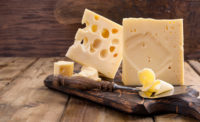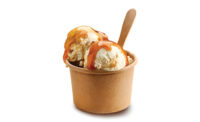2018 State of the Industry report: Cheese is a standout on the gridiron
Convenient offerings, adventurous flavors and natural positioning should keep cheese on top of its game


















Although its growth at retail has slowed down in recent years, the natural cheese category is still gaining yardage. Dollar sales in the total category rose 1% to $12.9 billion during the 52 weeks ending Aug. 12, 2018, data from Chicago-based market research firm IRI show. Unit sales increased 1.5%.
Processed cheese, however, continued to fumble at retail. Dollar sales fell 3.1% to $2.9 billion, while unit sales tumbled 4.1%.
Milk | Cheese | Cultured | Ice Cream | Butter | Non-dairy Beverages | Ingredients | Exports
But cheese’s future — on both the retail side and the even larger foodservice side — remains bright. According to a June 2018 report from Allied Market Research, Portland, Ore., the overall U.S. cheese market was valued at $32.3 million in 2017, and is projected to reach $40.5 million by 2025. That forecast reflects a respectable compound annual growth rate of 2.8% between 2018 and 2025.
Touchdown for convenience
Wielding a huge influence on the cheese segment is consumers’ desire for convenience. In fact, Allison Schuman, senior director of sales for Schuman Cheese, Fairfield, N.J., said convenience appears to be the “most influential trend” her company has seen in 2018.
“Consumers and companies alike want products in a convenient format,” she said. “Ease of use with high-quality cheese is a priority for both consumers and restaurants.”
Jim Dimataris, director of processor relations for the Tracy, Calif.-based California Milk Advisory Board, pointed to the rise of snacking cheeses that align with the convenience trend.
“Snacking cheeses with compartmentalized packages sold in the wall deli, produce department and service deli department, as well as dried cheeses converted into bars and bite-sized packaging for snacking, are among the most exciting and game-changing innovations in the cheese category,” he said. “The cheese in these unique packs serves as a key protein source to get double-digit grams of protein within the 100- to 200-calorie range, while the dried cheese snacks provide true on-the-go convenience — all key selling points for today’s consumer.”
One opportunity within the snack cheese segment can be found with Generation Z. These young consumers have an adventurous flavor palate, said Valerie Liu, marketing manager for the Jarlsberg and Old Amsterdam brands of Darien, Conn.-based Norseland Inc., and want more than the standard mozzarella stick for at-school snacking.
“Our Jarlsberg cheese snacks are the perfect alternative with a mild but nutty flavor profile,” she said.
And specialty snack cheeses from artisan cheesemakers are a draw with today’s consumers, noted Tim Omer, president and managing director of Emmi Roth, Fitchburg, Wis. Consumers shop the deli case only four times a year, he said, but the addition of specialty snack cheese items can generate more traffic to the area — and spur more interest in specialty cheese.
Emmi Roth recently debuted snack cheeses under its Roth brand. The 3/4-ounce round portion cheeses — in creamy cheddar, creamy Gouda and creamy whole-milk mozzarella — are individually wrapped and sold in six- and 10-count bags.
For its part, the Old Amsterdam brand added premium aged Gouda cheese bites to its lineup early this year. They come in six-packs of 0.5-ounce individually wrapped, easy-peel portions. The brand also introduced a limited-edition package of holiday Gouda “trees” that make it easy to add a festive note to holiday cheeseboards.
And Schuman pointed to the recent launch of Cello Cheese Flights as her company’s most exciting launch. Each tray features a trio of curated cheeses.
“The board helps consumers navigate a very cumbersome category and put together the perfect cheeseboard without a second thought,” she said. “It even suggests wine and beer pairings to help impress family and friends.”
Speaking of cheeseboards, Emmi Roth will be debuting the Roth Entertaining Cheeseboard this holiday season, Omer said. The convenience-minded offering aims to ease the stress of holiday entertaining. It combines three of the most popular varieties of Roth cheese with a bamboo cutting board and wooden cheese markers for labeling.
Flavors make the tackle
Flavored cheese options also are on trend. Case in point: Cary Frye, senior vice president of regulatory affairs for the Washington, D.C.-based International Dairy Foods Association, said she’s been fielding a lot more compliance-related questions from processors in reference to flavored cheeses and cheeses with spices or herbs. She pointed to Sartori, Plymouth, Wis., as a standout here with its BellaVitano brand.
“They started with flavors like merlot, espresso — these aren’t throughout the whole cheese, but they’re on the edges of the cheese to give a touch of delicious flavor,” Frye said. “Now they’re expanding to citrus ginger and chai.”
Blair Wilson, vice president of marketing for Sartori, called flavors one of the most exciting innovations within the cheese category.
“Domestic cheese manufacturers continue to innovate [with] new flavors and pairings that excite consumers and drive growth to the category,” he said.
Schuman noted that consumers are gravitating more and more often to “authentic and intense” flavor profiles. To help address that trend, Schuman Cheese has been working on Alpine flavor blends, which would have been “too polarizing” not too long ago.
“However, in the past year, these flavors have had a growing presence on menus,” she said. “Both at retail and with foodservice, we have seen blends growing, whether for melting, dishes like mac-and-cheese or something more unique.”
Although cheddar and mozzarella, sans extra flavors, remain the “headlines of the cheese world” in terms of sales volumes and consistent growth, it’s the specialty cheese flavors such as garlic dill, chipotle and Buffalo sauce that are experiencing the greatest growth now, noted Marshall Reece, senior vice president of sales and marketing for Associated Milk Producers Inc. (AMPI), New Ulm, Minn.
“AMPI’s smoked chipotle cheese is a new offering that’s doing well,” he added. “We continue to see positive growth of Monterey Jack with peppers and spice — the hotter, the better.”
Other flavored cheeses making a grand entrance this year include flavored fresh goat cheeses from Vermont Creamy, Websterville, Vt., and bold-flavored Aussie-style cheddars from the Old Croc brand (distributed by Trugman-Nash LLC, Millburn, N.J.). The goat cheeses, sold in 4-ounce logs, come in clover blossom honey, wild blueberry lemon and thyme, and smoky pepper jelly flavors. The 6-ounce packages of cheddar, meanwhile, are offered in horseradish; bacon and jalapeno; chipotle and onion; and roasted garlic and herb varieties.
And Cabot Creamery, Waitsfield, Vt., recently brought a bit of boldness to the shredded cheese segment with the introduction of a 15-SKU line of 8-ounce Cabot shredded cheeses in flavors such bacon cheddar, rustic pizza and mac & cheese.
‘Natural’ kicks the extra point
Today’s consumers also are looking for “minimal processing and maximum flavor,” Liu said.
That reality gives natural cheese an advantage over processed cheese — but it also is encouraging the entire cheese segment to take “natural” to new heights.
“We see the industry responding with clean labels, more transparent labeling and fewer ingredients,” Liu said.
Omer agreed, saying that today’s consumers expect their food to be “clean” — and the companies that make that food to be transparent.
“It’s more important than ever before for dairy companies to be honest with consumers about how their products are made,” he stressed.
For their part, retailers are looking for cheeses that communicate the position of “great taste and nutrition” on the natural cheese side, Dimataris added.
“Natural cheese provides the clean nutrition label consumers are seeking in a fresh product with a lot of flavor,” he said. “A wider variety of sliced natural cheeses and shredded cheeses have driven additional demand in the cheese category. Organics and grass-fed are also items retailers are stocking to address consumer preferences.”
Applegate Farms, a subsidiary of Austin, Minn.-based Hormel Foods, recently introduced a line of six natural sliced cheeses and three shredded cheeses under the Applegate Naturals brand. The non-GMO offerings are marketed as containing no added colors or artificial ingredients.
And BelGioioso Cheese, Green Bay, Wis., tapped into the natural trend (and well as the trend toward convenience) with the recent launch of all-natural cheeses in 4-ounce cups. The cups — available in Parmesan (grated, shredded and shaved varieties); a blend of Asiago, Fontina, Parmesan and provolone (shredded); and a salad blend of Asiago, Parmesan and Romano (shaved) — are marketed as containing only three ingredients: milk, enzymes and salt.
In addition to premium and specialty natural cheeses, Dimataris also noted increased interest in Hispanic cheeses such as Oaxaca, Mexican-style shreds, manchego and Cotija.
The best defense is a good offense
Despite consumers’ continued love affair with cheese and the rosy near-future forecast, the category is not without its challenges. For one thing, it’s crowded, Liu noted.
“One of the biggest challenges,” she said, “is how do we stand out, differentiate our products and get shoppers excited about picking up our cheese in store?”
A little bit of sampling and education can go a long way to address this challenge.
“Old Amsterdam recently completed a sampling tour around the Northeast, focusing on wine, food and art festivals,” Liu shared. “Jarslberg also launched a 16-day pop-up at a storefront in [New York’s] West Village, where people could come in to try samples, pairings and cheeseboards, as well as take pictures on a giant Jarlsberg wheel swing. When the digital strategy can be interwoven with in-person experiences, that creates a connection and memory that carry over to those future grocery shopping trips.”
The shift toward online shopping also creates a potential obstacle for the perishable category. Omer said dairy processors need to stay ahead of trends and work with retailers to ensure their products are available in stores and via retailers’ click-and-collect websites. They also need to find new avenues to market their cheese products and “stay relevant” in the minds of ever-evolving consumers.
Continued innovation is a must, too, but is not always easy. Such innovation need not result in a completely new product, Dimataris said, but instead could be a new way to use an existing item. He also sees an issue with cheese’s presentation at retail.
“While the category is shifting toward premium, many retailers’ cheese sections still emulate a commoditized look,” he said. “The natural cheese case can be refreshed by added more slices, shreds and snacking cheeses to the case. Chunk cheeses can include premium varieties of private label to spice things up.”
Space reductions within retail cheese sets are another pain point, Schuman said. She pointed to numerous such initiatives on the part of retailers in 2018 that favored of high-velocity items.
“This shift in major retailers has left less space for more specialty niche items, which means we need to make sure that any innovation in our pipeline is going to appeal to a broader market group and help answer that velocity demand.”
Ongoing trade disputes, too, have been negatively impacting the cheese category, Reece pointed out, a reality over which processors have little control. But processors could tap into other growth opportunities. One such opportunity is foodservice, which is growing at a greater rate than retail.
“We need to make sure we are making the cheese diners want to order when they are enjoying a meal away from home,” he said.
Despite the challenges, cheese consumption within the U.S. continues to grow. Even better news? The category still has plenty of room to expand.
“Globally, Americans rank 19th in cheese consumption, at 36.9 pounds [annually],” Reece pointed out, citing 2016 data. “This remains far behind … Denmark, where the average person consumes 61.9 pounds of cheese each year.”
Milk | Cheese | Cultured | Ice Cream | Butter | Non-dairy Beverages | Ingredients | Exports
Looking for a reprint of this article?
From high-res PDFs to custom plaques, order your copy today!
















